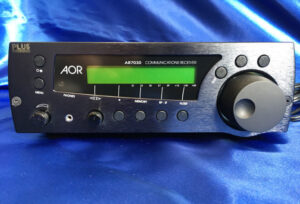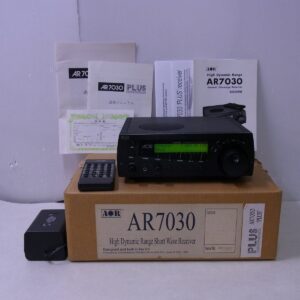The Robinson Report – February, 2023
The AOR 7030/Plus: What More Does Anyone Need?
 This month I continue my focus on some classic receivers with a look at one that really turned heads when it was released in the mid to late 1990s, and still has a special placein the collections of veteran DX’ers: the AOR 7030/Plus.
This month I continue my focus on some classic receivers with a look at one that really turned heads when it was released in the mid to late 1990s, and still has a special placein the collections of veteran DX’ers: the AOR 7030/Plus.
The 7030 arrived in my shack about a decade ago. Before that, I had never tried the receiver though it had accumulated numerous superb reviews during its production run from 1996 to 2008.
“In terms of sheer performance for program listening,” Larry Magne observed in the 2005 Passport to World Band Radio,”[the 7030 is] as good a radio as we’ve ever tested…ergonomics and slightly limited sensitivity to weak signals aside, the 7030 is arguably the best choice – certainly among the best of choices – for serious DXing available on the scotch side of a professional-grade model.”
Magne equated operating a 7030 to a BMW 745i, referring to what he called Star Trek ergonomics. That’s one area where, as he noted, the receiver is either the “ne plus ultra” for those who love it, or just not worth the bother for others.
After a number of years of using the 7030, I am firmly in the “ne plus ultra” group and the 7030 is now firmly among my top 20 receivers, even better if one has the Plus version, better still if you’re lucky to obtain one with the UPNB7030 option enabling an amazing automatic notch filter and noise blanker.
There are too many aspects of the 7030 to go over in limited space available here, but I’ll summarize:
-
Extraordinary overall quality, like using a piece of professional audio equipment.
-
Though frustrating to those who haven’t mastered it, the 7030 provides numerous front panel accessible tools to adjust signals and sound.
-
Auto-notch filtering capability that can also be turned off via menu selection.
-
Auto-synchronous tuning that locks on and stays locked, but which can also be turned off via menu.
-
As many as six filter positions, with a built-in function to calibrate filter properties via menu.
-
True Passband Tuning at PLUS or MINUS 4.2 khz accessible from the front panel in any mode.
-
Treble, Bass and RF Gain controls accessible via front panel, with Gain adjustable for manual or automatic.
-
Superb AGC choices, easily selectable via front panel, of OFF, SLOW, MEDIUM, FAST.
-
Superb top-firing speaker, which though criticized by some, is more than adequate for room-filling sound.
-
Rear controls include WHIP, 50 ohm, and WIRE antenna and display contrast adjustment.
With its heavy metal cabinet and small size, the 7030 is perfect for field operation – indeed, two of these receivers can easily fit in a mid-size Pelican or equivalent case.
There is an abundance of information online about the 7030. The most detailed content can be found at the website of Dave Zantow. Radio Netherlands did a review many years ago that is still very useful today. And eHamnet has a number of user reviews going back to 2001: https://www.qsl.net/n9ewo/ar7030.html and https://mwcircle.org/legacy-receiver-reviews/receiver-review-aor-ar-7030-2/ and https://www.eham.net/reviews/view-product?id=475
I came to love the 7030 so much that I now have seven of the receivers, all but two with the PNUB7030 features. Several of my sets were modified by Rick Krzemien, who ran Big Sky Audio in Montana (Rick is unfortunately no longer in business. He also did replacements of the internal battery in the receiver).
I’ll leave it to readers here to do their own searches, and gather information on the pros and cons of the 7030. In my book, the positives far outweigh the negatives. As Zantow notes, there were QC issues with displays, some of which dimmed over time, and issues with the tuning encoders on some units.
The original AOR power supply is another issue, though I have had no problems with mine (Dave provides a solution in his review). Perhaps the biggest additional issue involves the cabinet screws which were made of soft metal and are easily stripped. In fact, there is a specific order for taking the cabinet apart and considering that the 1/3 AA size battery might indeed need replacing at some point, this is important to know.
Among my personal nitpicks: from unit to unit there can be a bit of error when using LSB2 or USB2, though most of my receivers are pretty much on the money when it comes to calibration; one is about 20 Hz high in USB. In CW, there is a fine-tuning function adjustable from the front panel.
S o, how does the 7030 perform? In my view, it is simply a joy to operate, with more happiness to be found in the beautiful audio it produces. I don’t use external speakers on my 7030s and the sound easily fills a large room.
There are the usual complaints from some users about ergonomics. One reviewer on eHamnet discussed difficulty with AGC performance. I have found no problem with this, and once you master how the MENU system works and which buttons bring up which controls, operation is really a breeze.
Another feature is FAST tuning mode, enabled with a button press that easily and quickly can get you from bottom to the top of the frequency range. This is similar to the FAST mode in the Lowe HF-250/E, but superior since you can lock in FAST without having to hold a finger on the button.
Anyone looking for a 7030 should know that while they are not the rarest receiver on the used market, they also do not appear frequently. The one exception was the Japan Buyee site which until 2022 provided a way to bid on equipment on the Japanese2 used market.
That all changed when some of us who were regular Buyee users noticed a new ban imposed apparently because of Japan government restrictions on shipping radios and related equipment to foreign countries including, inexplicably, the United States. Quite a few 7030 receivers appeared on Buyee. Unless things change that’s the end of that.
The other obvious places to check are QRZ.com, eHamnet, and Ebay where occasionally one sees 7030 base models and Plus versions. A few years ago, one overseas seller was offering a PNUB7030 card for sale, which I promptly snapped up for use in one of my several 7030 receivers. Also found on the used market in recent years were a firmware upgrade module, and remote controls.
My advice for those who have never used a 7030 would be: understand the pros and cons of the receiver. As always, ask questions of a seller about operating and physical condition. Are all front control buttons operational? Has the internal battery ever been replaced? Has the cabinet ever been taken apart and if so, have any of the top or front panel screws been stripped? Is the original power supply with the radio? What about the remote control?
Generally, it’s preferable to have a 7030 that is at the higher end of serial numbers – I usually watch for receivers that are minimally between 102000 and 104000 or higher. However, that doesn’t mean that a receiver lower than this range will not work without a problem.
In early 2023, I decided to start a new group devoted to the AOR 7030 at Groups.io, as well as a new Facebook group. We welcome all newcomers at: https://groups.io/g/AOR7030 and https://www.facebook.com/groups/682696350243401
